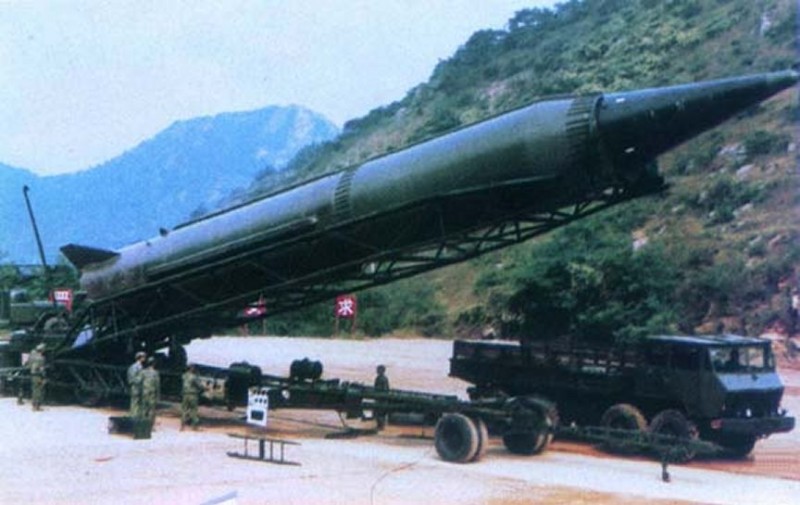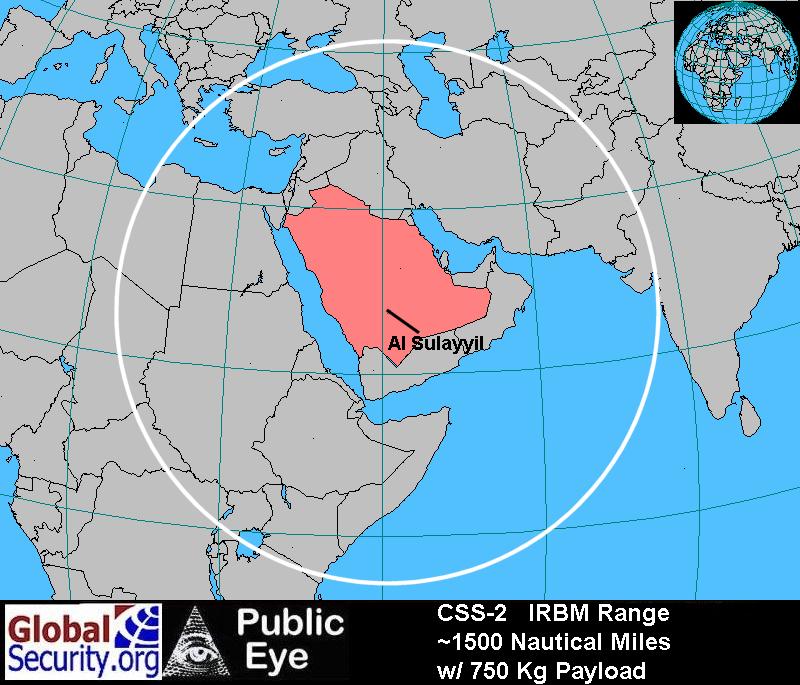DF-4 CSS -3
Following the successful test of atomic weaponry in 1964 and a thermonuclear (hydrogen) device in 1967, the next step of PRC’s strategic weapon programme was to develop delivery systems with different ranges. The two-stage DF-4 began development in 1967 and its development essentially took place in parallel with the single-stage DF-3 (CSS-2). The DF-4 was based on the same liquid propellant rocket engine of the DF-3, but with a second-stage which increased the missile’s range to over 4,000km. During its development, the design team encountered a number of technical difficulties, including the ignition of the second-stage rocket at high-altitude and the warhead’s re-entry heat-proof shield.
DF-4 displayed during the 1984 National Day military parade in Beijing (Chinese Internet)
The first flying test of the DF-4 missile took place in November 1969, but the first and second stages of the missile failed to separate due to commanding system failure and the missile was self-destructed. The revised missile was tested again in January 1970 with complete success. Following a redesign in order to increase the range, the missile was retested in May 1976. The missile first entered operational service with the PLA Second Artillery Corps between 1979 and 1980.
The DF-4 was the first ballistic missile of the PRC that posed a real threat to the Soviet Union, with its 4,750km range enough to reach Moscow and a number of other key Russian cities. The missile could also threaten U.S. military bases in its Asian allies, though it still could not reach the U.S. mainland. The missile’s primitive inertial guidance was insufficient to hit point targets such as missile sites, but the size of its warhead was enough to destroy large population centres and military complexes. This capability significantly boosted PRC’s ability to counter the nuclear threats of the Soviet Union following the split of the two communist allies in 1960.
Operational Status
The deployment of the DF-4 has been slow, with only two missiles reported to be operational in 1980. An additional 25~30 missiles could have been deployed by the late 1980s before the production stopped. Most of these missiles are deployed in central and western part of China to access the targets in the European part of the Soviet Union. Initially these missiles was deployed in silos, but they are later stored in underground missile complexes built in the caves inside mountains. The missiles are prepared for launch in the caves and then moved outside immediately before launching. The 2008 Pentagon report on the PRC’s military power estimated that there were approximately 20 DF-4 missiles in deployment by 2008.
DF-4 in operational service with the PLA Second Artillery Corps (Chinese Internet)
Design
The DF-4 is a two-stage, single-warhead liquid-propellant ballistic missile. The missile has a maximum range of 4,750km and a payload of 2,200kg. It carries a single 1,000~3,000kt thermonuclear warhead, with an accuracy of around 1,500m. The missile body has four clipped delta fins at the base of the first stage. The first stage is an up-rated DF-3 (CSS-2) stage with four YF-2A motors giving a total thrust of 104t. The second stage has one YF-3 motor giving 32t thrust. Both stages use the same storable liquid propellants UDMH and AK-27.
An Internet source photo of what was thought to be a DF-4 launch silo (Chinese Internet)
An inside view of a DF-4 silo (Chinese Internet)
Specifications
Configuration: Two-stage
Length: 28m
Diameter: 2.25m
Launch Weight: 82,000kg
Propellant: Liquid
Guidance: Inertial
Deployment: Silo and semi-mobile (towed trailer)
Range: 4,750km
Payload: 2,200kg
Warhead: 1,000~3,000kT yield thermalnuclear








